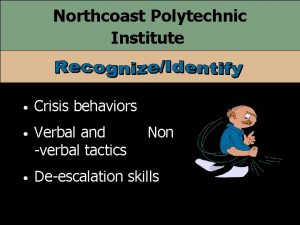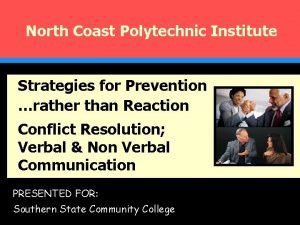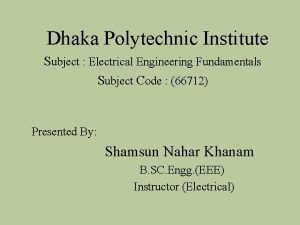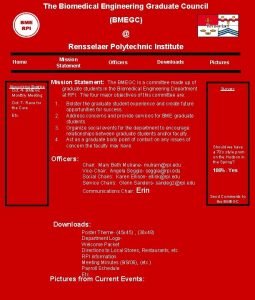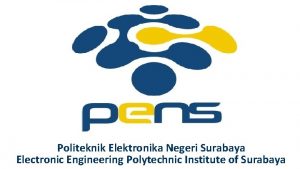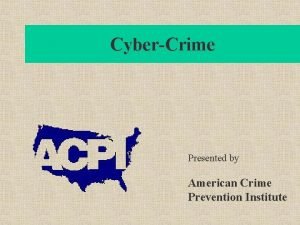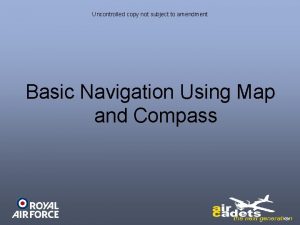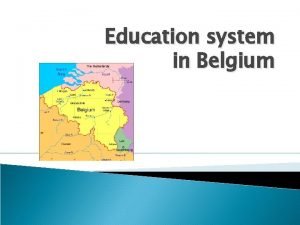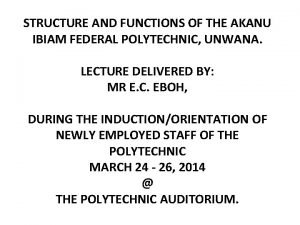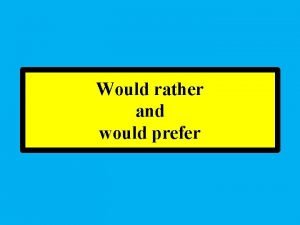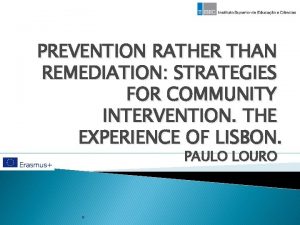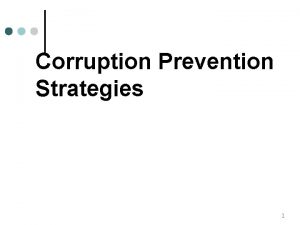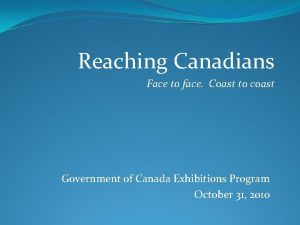North Coast Polytechnic Institute Strategies for Prevention rather



























- Slides: 27

North Coast Polytechnic Institute Strategies for Prevention …rather than Reaction Conflict Resolution; Verbal & Non Verbal Communication PRESENTED FOR: Southern State Community College

North Coast Polytechnic Institute William D. Healy Director (440) 353 -0796 Web: www. ncpi-ohio. com E-mail: info@ncpi-ohio. com PRESENTED FOR: Southern State Community College

Communication is humanity’s supreme achievement • Effective Communication = Successful Intervention • Ineffective Communication = Unsuccessful Intervention

• Recognize main causes of conflict • Recognize what escalates & deescalates conflict • Understand that communication is composed of verbal, non-verbal and para-verbal elements • Discuss methods that can be used to develop more effective listening skills • Discuss nonverbal communication and body language

5 Main Causes of Conflict Recognizing these causes is the first step in dealing with conflict situations. • Differing values • Making assumptions • Differing expectations • Differences in the way you were brought up • Knowledge and ability to cope with conflict

• There is an increase in emotions like anger, frustration, etc. • One feels that they are being threatened. The conflict • People get involved, choosing sides. • The individuals were not friendly prior to the conflict. • The individuals have few peace making skills. • They like to engage in conflict. 6

• Attention is focused on the problem, not the participants • There is a decrease in emotion and perceived threat. The conflict • The individuals were friendly prior to the conflict. • They know how to make peace, or have someone help them do so. • There is a desire to reduce conflict. 7

6 Steps to Conflict Resolution 1. Discuss the situation in a respectful manner 2. Be specific 3. Discuss how a conflict (or problem) impacts them, you, the work group or project. (What do you feel is going on? ) (Remember, you are asking not telling. ) 8

6 Steps to Conflict Resolution (cont’d) 4. Ask for the specific cause of the conflict. (From your perspective, what is happening here? ) (Yes, I can imagine the challenge this presents – and we need to come up with a solution. What ideas might you have? ) 9

6 Steps to Conflict Resolution (cont’d) 5. Ask for the solution. (For instance, “What do you think you need to do to help solve this situation? What is the next step? ”) (This brings in accountability. ) 10

6 Steps to Conflict Resolution (cont’d) 6. Agree on the action to be taken. (This step is often missed and it’s the most important one. Close on a positive note and ask them to get back to you on the outcome. ) 11

Conflicts are: • Inevitable. • Potentially beneficial, if appropriate management strategies are used. • Now that you know the ‘main causes of conflict and different conflict resolution approaches’, you are better equipped to recognize and deal with any future conflicts.

Strategies for Prevention • “The Power of Communication through Listening” • Empathetic Listening and Compassion for People

#1 How well we Listen • 55% Non-verbals and Body Language • 38% How we say words and sounds we make • 7% Words we use

#2 How well we Listen • Listening is an art of actively paying attention to a person’s words, nonverbal cues, and feelings that are indirectly expressed. We listen to what he or she says, feels and expresses through gestures.

#3 How well we Listen • We listen to what the person “means” by comparing his or her words with the feelings we get from the nonverbal language. We listen to how a word is used, how a sigh is expressed, how the voice sounds, and what the face shows.

#4 How well we Listen • Extreme and concentrated listening requires a lot of patience and openmindedness on the part of the listener. It is important to make the client feel that you are listening.

#5 How well we Listen • Use good nonverbal behaviors like eye contact, nodding the head, touching the hand, etc. Restate the words of the person to let him or her know that he or she has been heard. This can help to clarify what the person has expressed.

Choose words carefully • “I’ll try” – These words show no commitment. • “But” – Hints that whatever comes next is negative. • “It’s (Not) our policy” – State what the policy is to the person. Inform and provide options.

The goal here is to establish a rapport with the person I can understand that you… – feel that way – think that – are concerned about that – are upset – I hear what you’re saying – I see what you mean – I don’t blame you

The goal here is to establish a rapport with the person • “Others have felt the same way” • “No one likes that” • “I’ve felt that way at times myself” This approach takes the focus away from the person’s singular position and lets them know they are not alone.

Nonverbal communication, or body language, is a vital form of communication. When we interact with others, we continuously give and receive countless wordless signals. All nonverbal behaviors – the gestures we make, the way we sit, how fast or how loud we talk, how close we stand, how much eye contact we make – send strong messages. The power of nonverbal communication and body language (1)

The nonverbal signals you send either produce a sense of interest, trust and desire for connection – or they generate disinterest, distrust and confusion. The power of nonverbal communication and body language (2)

“First Impressions” Group Exercise • Review the “First Impressions” handout and discuss what nonverbal messages you might be sending in each of the twelve nonverbal behaviors. • Be prepared to discuss with class. It has been said that actions speak louder than words.

Types of nonverbal communication & body language There are many different types of nonverbal communication. Together, the following nonverbal signals and cues communicate your interest and investment in others. (#1) Facial Expressions Gestures Eye Contact Touch Body movements and posture

Types of nonverbal communication & body language (#2) Think about the messages given by the following: a firm handshake; a timid tap on the shoulder; a warm bear hug; a reassuring pat on the back; a patronizing pat on the head; or a controlling grip on your arm. Space 26

• Effective communication and the development of effective listening skills is critical for recognizing and preventing a “Conflict” from turning into a “Crisis”. • We need to develop strategies for “Prevention” rather than “Reaction” • Build relationships with patients/clients, so you can recognize the verbal, nonverbal, and paraverbal cues they exhibit. 27
 North coast polytechnic institute
North coast polytechnic institute North coast polytechnic institute
North coast polytechnic institute Primary prevention secondary prevention tertiary prevention
Primary prevention secondary prevention tertiary prevention Jhenaidah polytechnic institute
Jhenaidah polytechnic institute National university polytechnic institute
National university polytechnic institute Dhaka polytechnic institute subject
Dhaka polytechnic institute subject Worcester polytechnic institute chemical engineering
Worcester polytechnic institute chemical engineering Rensselaer polytechnic institute electrical engineering
Rensselaer polytechnic institute electrical engineering National technical university kharkiv polytechnic institute
National technical university kharkiv polytechnic institute Rensselaer polytechnic institute biomedical engineering
Rensselaer polytechnic institute biomedical engineering 3341101
3341101 Electronic engineering polytechnic institute of surabaya
Electronic engineering polytechnic institute of surabaya Dhaka polytechnic institute
Dhaka polytechnic institute Groynes
Groynes North coast prep
North coast prep American crime prevention institute
American crime prevention institute True north vs magnetic north
True north vs magnetic north North east and north cumbria integrated care system
North east and north cumbria integrated care system Chapter 14 north and south
Chapter 14 north and south The north pole ____ a latitude of 90 degrees north
The north pole ____ a latitude of 90 degrees north 6th grade in belgium
6th grade in belgium Chandil polytechnic
Chandil polytechnic Army polytechnic school
Army polytechnic school Organogram of a polytechnic
Organogram of a polytechnic Perm national research polytechnic university
Perm national research polytechnic university Tomsk polytechnic university rector
Tomsk polytechnic university rector Tomsk polytechnic university rector
Tomsk polytechnic university rector Kombolcha polytechnic college
Kombolcha polytechnic college
